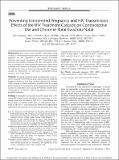| dc.contributor.author | Raifman, Julia | en_US |
| dc.contributor.author | Chetty, Terusha | en_US |
| dc.contributor.author | Tanser, Frank | en_US |
| dc.contributor.author | Mutevedzi, Tinofa | en_US |
| dc.contributor.author | Matthews, Philippa | en_US |
| dc.contributor.author | Herbst, Kobus | en_US |
| dc.contributor.author | Pillay, Deenan | en_US |
| dc.contributor.author | Bärnighausen, Till | en_US |
| dc.date.accessioned | 2015-01-05T18:26:44Z | |
| dc.date.issued | 2014 | en_US |
| dc.identifier.citation | Raifman, Julia, Terusha Chetty, Frank Tanser, Tinofa Mutevedzi, Philippa Matthews, Kobus Herbst, Deenan Pillay, and Till Bärnighausen. 2014. “Preventing Unintended Pregnancy and HIV Transmission: Effects of the HIV Treatment Cascade on Contraceptive Use and Choice in Rural KwaZulu-Natal.” Journal of Acquired Immune Deficiency Syndromes (1999) 67 (Suppl 4): S218-S227. doi:10.1097/QAI.0000000000000373. http://dx.doi.org/10.1097/QAI.0000000000000373. | en |
| dc.identifier.issn | 1525-4135 | en |
| dc.identifier.uri | http://nrs.harvard.edu/urn-3:HUL.InstRepos:13581074 | |
| dc.description.abstract | Background: For women living with HIV, contraception using condoms is recommended because it prevents not only unintended pregnancy but also acquisition of other sexually transmitted infections and onward transmission of HIV. Dual-method dual-protection contraception (condoms with other contraceptive methods) is preferable over single-method dual-protection contraception (condoms alone) because of its higher contraceptive effectiveness. We estimate the effect of progression through the HIV treatment cascade on contraceptive use and choice among HIV-infected women in rural South Africa. Methods: We linked population-based surveillance data on contraception collected by the Wellcome Trust Africa Centre for Health and Population Studies to data from the local antiretroviral treatment (ART) program in Hlabisa subdistrict, KwaZulu-Natal. In bivariate probit regression, we estimated the effects of progressing through the cascade on contraceptive choice among HIV-infected sexually active women aged 15–49 years (N = 3169), controlling for a wide range of potential confounders. Findings: Contraception use increased across the cascade from <40% among HIV-infected women who did not know their status to >70% among women who have been on ART for 4–7 years. Holding other factors equal (1) awareness of HIV status, (2) ART initiation, and (3) being on ART for 4–7 years increased the likelihood of single-method/dual-method dual protection by the following percentage points (pp), compared with women who were unaware of their HIV status: (1) 4.6 pp (P = 0.030)/3.5 pp (P = 0.001), (2) 10.3 pp (P = 0.003)/5.2 pp (P = 0.007), and (3) 21.6 pp (P < 0.001)/11.2 pp (P < 0.001). Conclusions: Progression through the HIV treatment cascade significantly increased the likelihood of contraception in general and contraception with condoms in particular. ART programs are likely to contribute to HIV prevention through the behavioral pathway of changing contraception use and choice. | en |
| dc.language.iso | en_US | en |
| dc.publisher | JAIDS Journal of Acquired Immune Deficiency Syndromes | en |
| dc.relation.isversionof | doi:10.1097/QAI.0000000000000373 | en |
| dc.relation.hasversion | http://www.ncbi.nlm.nih.gov/pmc/articles/PMC4251916/pdf/ | en |
| dash.license | LAA | en_US |
| dc.subject | unintended pregnancy | en |
| dc.subject | HIV | en |
| dc.subject | AIDS | en |
| dc.subject | reproductive health | en |
| dc.subject | contraception | en |
| dc.subject | condoms | en |
| dc.subject | HIV transmission | en |
| dc.title | Preventing Unintended Pregnancy and HIV Transmission: Effects of the HIV Treatment Cascade on Contraceptive Use and Choice in Rural KwaZulu-Natal | en |
| dc.type | Journal Article | en_US |
| dc.description.version | Version of Record | en |
| dc.relation.journal | Journal of Acquired Immune Deficiency Syndromes (1999) | en |
| dc.date.available | 2015-01-05T18:26:44Z | |
| dc.identifier.doi | 10.1097/QAI.0000000000000373 | * |


